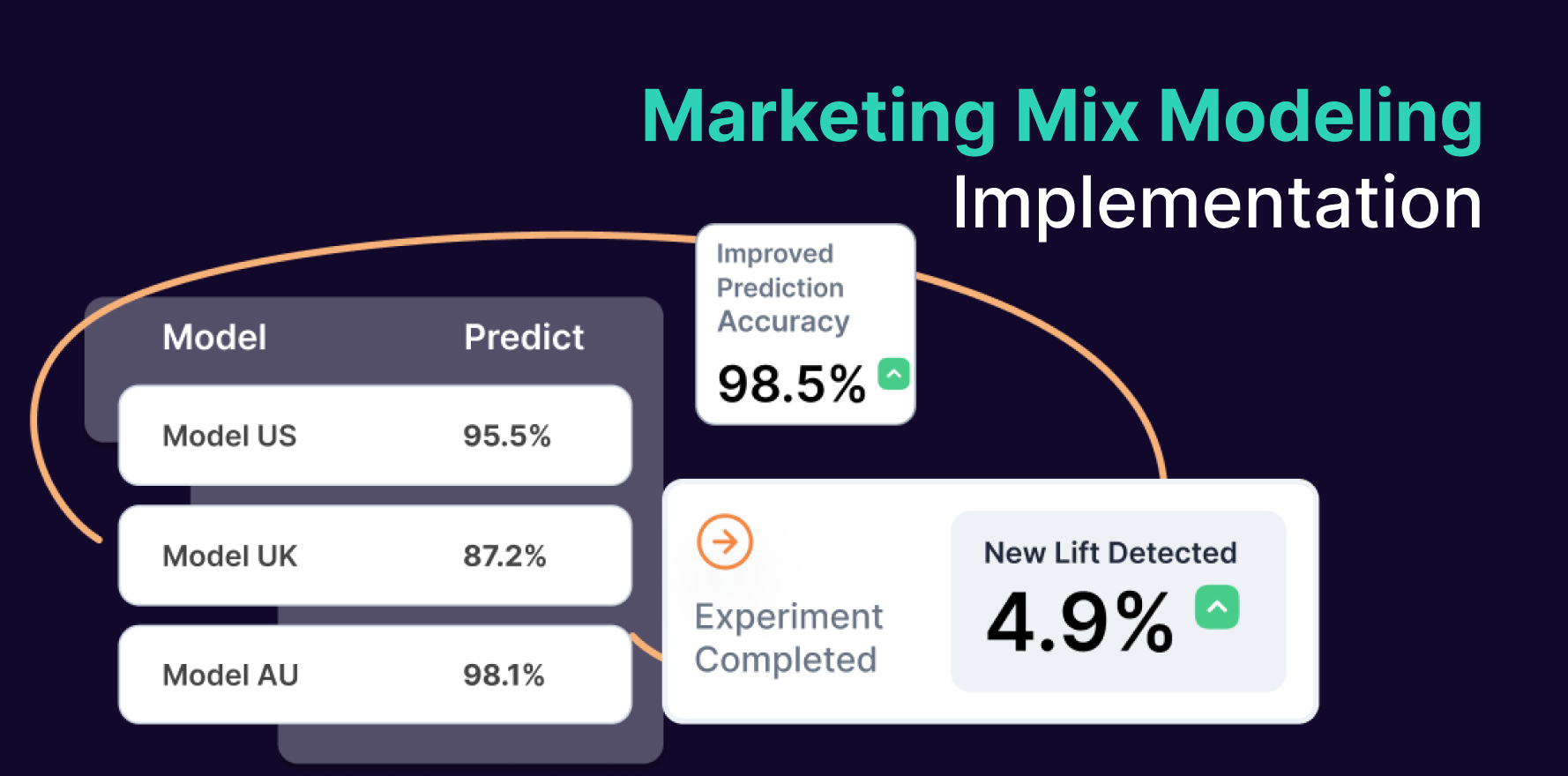Modern customer journeys are no longer a straight line journey. Consumers today engage with brands across a mix of digital and offline touchpoints: scrolling through Instagram, clicking on Google ads, opening emails, visiting physical stores, and more, before making a purchase decision. This fragmented path to conversion makes it increasingly difficult for marketers to determine which channels actually influence buying behavior.
This complexity is not just a challenge; it’s a business risk. According to Google, 60% of marketing leaders struggle to measure ROI across digital channels, leading to inefficient budget allocation and missed opportunities. When it’s unclear which tactics drive results, marketing becomes a guessing game, resulting in wasted spend on underperforming platforms and underinvestment in high-impact channels.
Understanding which touchpoints contribute to conversions is essential for optimizing campaigns, improving customer experiences, and driving growth. It enables marketers to allocate budgets strategically, tailor messaging by channel, and ultimately, prove the value of their efforts to leadership.
In this context, attribution models, especially Multi-Touch Attribution (MTA), have become vital tools for decoding performance. But as we’ll explore next, even MTA has its limitations.
Read About: Best Multi-touch Attribution Tools in 2025
What is Multi-touch Attribution (MTA)?
Multi-Touch Attribution (MTA) is a marketing measurement technique that evaluates the influence of each interaction a consumer has with a brand across their path to conversion. Rather than crediting a single channel for driving a sale, as traditional models do, MTA recognizes that modern purchase decisions are shaped by a sequence of touchpoints, from initial awareness to final action.
Whether it’s a user clicking a Facebook ad, opening a marketing email, performing a Google search, or engaging with a retargeting display ad, MTA aims to quantify the role each of these interactions plays in moving the customer closer to conversion. By distributing credit across these touchpoints, MTA helps marketers better understand how different channels work together to drive results.
This holistic view allows for more precise budget allocation, campaign optimization, and strategic planning. It moves marketers away from guesswork and toward data-backed decision-making, which makes MTA an essential component for businesses looking to optimize ROI in today’s multi-channel landscape.
Multi-touch Attribution Model Example
Imagine a potential customer who’s in the market for noise-canceling headphones. Over the span of ten days, they interact with your brand multiple times:
- Day 1: They click on a Google Search ad while researching headphone options.
- Day 3: They return to your site directly after bookmarking it.
- Day 5: A Facebook retargeting ad reminds them of your product.
- Day 7: They open a promotional email offering a limited-time discount.
- Day 10: They see a Connected TV (CTV) ad while watching a show. Prompted by the reminder, they conduct another Google search and click on a branded search ad – which leads to the final purchase.
So, which of these interactions deserves the credit for the sale?
Types of Multi-touch Attribution
Here’s how different types of Multi-Touch Attribution (MTA) models might interpret the journey
1. Linear Attribution
Each of the six touchpoints receives equal credit (16.67% each). This model is simple and acknowledges that every interaction played a role, but it doesn’t differentiate between more influential or passive moments.
2. Time Decay Attribution
The closer the touchpoint is to the conversion, the more credit it gets. So the branded search ad and the CTV exposure would get the highest weight, while earlier steps like the initial Google Search click and direct visit would receive less. This model assumes recency correlates with influence.
3. U-Shaped Attribution
This model gives most of the credit to the first touch (Google Search ad) and the last major interaction before conversion (branded search ad), typically assigning around 40% to each. The remaining 20% is shared between the direct visit, Facebook ad, promotional email, and CTV exposure.
4. W-Shaped Attribution
Credit is shared among three pivotal moments: the first interaction (Google Search ad), a mid-funnel engagement (e.g., Facebook ad or promotional email), and the final conversion (branded search ad). This model is ideal for campaigns that rely on both awareness and nurturing to drive decisions.
5. Data-Driven Attribution
Instead of relying on preset rules, this model uses historical data and machine learning to determine how much each touchpoint contributed to the conversion. If past data shows that CTV ads significantly boost branded search conversions, it might attribute more credit to the CTV impression than any rule-based model would.
Each model tells a slightly different story, and choosing the right one depends on the nature of your product, sales cycle, and how deeply you want to understand customer behavior. The real power of MTA lies in its ability to make these interactions visible, so marketing teams can spend smarter and optimize more effectively.
Limitations of Using a Multi-touch Attribution (MTA) Model
While Multi-Touch Attribution (MTA) promises a more nuanced view of marketing performance, it has several critical limitations that undermine its effectiveness, especially in today’s privacy-conscious, multi-device world.
1. Correlation, Not Causation
MTA models observe and assign credit to touchpoints based on user paths but stop short of identifying what actually caused a conversion. Without understanding causality, marketers can easily misattribute value to actions that merely coincided with conversions, leading to flawed optimization decisions.
2. Over reliance on Customer Journeys That Are No Longer Trackable
MTA fundamentally depends on stitching together user-level journeys across platforms and devices. However, privacy regulations like GDPR, CCPA, and the deprecation of third-party cookies have made this tracking incomplete or impossible. Users’ actions often go unrecorded or are anonymized, leading to fragmented data and distorted customer paths. This breaks the core logic MTA relies on an intact and observable journey.
3. No Measure of Incrementality
MTA assumes that touchpoints directly influence behavior, but it doesn’t test this assumption. It can’t tell you what would have happened if the user hadn’t seen the ad. Without measuring lift through controlled experiments or quasi-causal methods, MTA often overstates the impact of visible touchpoints.
4. Digital-Only View of Marketing Impact
Offline channels like TV, radio, print, in-store experiences, and even word-of-mouth remain blind spots in most MTA models. As a result, the influence of non-digital media is underestimated or entirely omitted, creating an incomplete picture of marketing effectiveness.
5. High Engineering Complexity, Low Strategic Value
Building and maintaining an MTA system requires heavy investments in data engineering and identity resolution. Despite this, the output often serves only operational decisions, such as which ad or campaign performed best. It offers little support for higher-order strategic planning like budgeting or forecasting.
6. Misleading Patterns and Statistical Noise
MTA models often pick up on patterns that are merely coincidental, not meaningful. With no ability to differentiate between true drivers and spurious correlations, they can nudge marketers into making costly missteps based on unreliable insights.
How does switching to Causal Attribution Solve the Limitations of MTA Multi-touch attribution (MTA) Work?
Causal attribution offers a fundamentally different approach from traditional MTA, shifting the focus from who saw what to what actually worked. Where MTA tries to assign credit based on observed paths, causal attribution aims to answer the more impactful question: did a specific marketing effort truly cause a lift in conversions?
Here’s how it overcomes the major shortcomings of MTA:
1. From Correlation to Causation
Unlike MTA, which merely tracks associations, causal attribution uses statistical and experimental methods such as geo-testing, randomized control trials (RCTs), or time-based experiments to isolate the true effect of marketing. This shift from correlation to causation helps marketers avoid false positives and invest with confidence in what genuinely drives results.
2. Works Without User-Level Journey Stitching
Causal models don’t require complete customer journeys. This is a game-changer in a privacy-first world where user-level data is sparse, siloed, or anonymized. By analyzing aggregated outcomes and using controlled testing environments, causal attribution bypasses the need for invasive tracking while still delivering meaningful insights.
3. Measures True Incrementality
At the heart of causal attribution is the concept of incrementality: understanding how much additional impact a marketing activity had beyond what would have occurred naturally. It reveals whether that Facebook campaign actually drove new conversions or simply captured demand that was already there. This clarity is critical for budget planning and performance optimization.
4. More Inclusive of All Channels
Causal attribution frameworks can incorporate both digital and offline channels. Whether it’s a connected TV ad, in-store promotion, or influencer campaign, causal testing allows brands to assess the real contribution of each initiative, even those that MTA cannot observe directly.
5. Strategic Utility Beyond Click Paths
Causal insights are not just operational; they’re strategic. Brands can use them to set budget mixes, evaluate partner performance, forecast impact, and guide high-stakes decisions. It empowers leadership with robust, evidence-backed metrics, not just click-path storytelling.
6. Resilience Against Data Fragmentation
With causal methods, you don’t need to track users across every click and impression. That makes these models far more resilient in the face of rising data privacy barriers and platform walled gardens. As user-level signals become less reliable, causal attribution stands out as a sustainable alternative.
Implementation: Multi-Touch Attribution (MTA) vs. Causal Attribution
When it comes to putting theory into practice, the gap between Multi-Touch Attribution (MTA) and Causal Attribution becomes even more evident. While both approaches aim to measure marketing effectiveness, they require very different tools, data, and organizational readiness to implement successfully.
Implementing Multi-Touch Attribution (MTA)
MTA demands a robust infrastructure to track and link user interactions across multiple devices and platforms.
Here’s what that typically involves:
- Extensive Data Engineering: You need systems capable of collecting granular user-level data across paid, owned, and earned channels.
- Identity Resolution: Stitching together cross-device and cross-platform behaviors requires complex identity graphs or persistent user identifiers, which are increasingly restricted under new privacy regulations.
- Attribution Algorithms: Once the journeys are stitched, you must apply rule-based or algorithmic models to allocate credit, often involving third-party attribution vendors or in-house data science teams.
- Maintenance & Compliance: Keeping the system updated amidst evolving tech stacks, tracking changes, and privacy laws adds continuous overhead.
Despite this heavy lift, MTA insights mostly support tactical or operational decisions, such as which ad, creative, or campaign performed best.
Implementing Causal Attribution
Causal attribution, by contrast, relies less on individual tracking and more on designing controlled experiments or using statistical inference to understand lift.
Here’s what implementation looks like:
- Controlled Testing Design: Marketers set up geo-based or time-based experiments to compare treatment vs. control groups—e.g., running an ad in one region while holding spend in another.
- Test Execution & Monitoring: Requires disciplined execution and data collection over time, often supported by platforms that specialize in lift measurement and incrementality testing.
- Statistical Analysis: The results are analyzed using causal inference methods (like Difference-in-Differences, Synthetic Controls, or Bayesian modeling) to isolate the true impact.
- Scalability via Calibration: Once calibrated, these results can refine broader models like MMM or even adjust attribution weights in real-time platforms.
What’s noteworthy is that causal attribution doesn’t demand user-level data or identity stitching, making it far more privacy-compliant and future-proof.
Feature |
MTA |
Causal Attribution |
| Data Needs | High – user-level, identity stitched | Moderate – aggregated or cohort-level |
| Privacy Compliance | Low (increasingly restricted) | High (works without PII) |
| Setup Complexity | High – ongoing maintenance required | Moderate – once designed, repeatable |
| Decision Utility | Tactical/Operational | Strategic and Tactical |
| Resilience to Data Gaps | Low | High |
While MTA might offer granular insights, causal attribution provides actionable truth. It’s not just easier to scale under data constraints; it also supports more confident decisions across the full marketing funnel.
How Lifesight can Enhance your existing Multi-Touch Attribution and turn it into Causal Attribution?
If you’re already using Multi-Touch Attribution (MTA), you’re halfway to understanding your marketing performance. But what if you could take that insight to the next level by moving from observed behavior to actual impact? That’s exactly what Lifesight enables.
Rather than discarding your existing MTA setup, Lifesight enhances it by layering in causal inference, calibration, and incremental measurement. This transforms directional insights into dependable action.
1. Anchor Attribution: Your Chosen Source of Truth
Lifesight’s framework starts by allowing marketers to select an “anchor attribution” source, whether it’s platform-reported data (like Meta or Google), GA4, or Lifesight’s own modeled attribution. This anchor acts as the baseline for touchpoint credit allocation. Instead of using this data blindly, Lifesight applies incrementality factors (iFactors) and marginal factors (mFactors) derived from experiments and Marketing Mix Modeling (MMM) to calibrate the numbers.
This means your anchor attribution becomes smarter and is corrected for over- or under-crediting based on causal truths. You can continue using your familiar tools, but now with far more accuracy.
2. Calibrating Attribution with Real-World Experiments
Through geo and time-based testing, Lifesight measures the actual lift driven by specific marketing efforts. These results are then used to adjust your anchor attribution. This calibration ensures the credit given to each channel aligns with what actually moved the needle, not just what got clicked.
3. Deduplication Across Platforms
One of the biggest problems with MTA is credit inflation, where every platform takes credit for the same conversion. Lifesight solves this by deduplicating attribution credits using calibrated impact estimates. This eliminates overlap and ensures total attribution reflects true business impact, not just visibility.
4. Resilience to Privacy and Tracking Limitations
Unlike traditional MTA, Lifesight’s causal models don’t rely on stitching together user journeys. This makes them privacy-compliant and highly resilient in environments where third-party cookies and persistent identifiers are disappearing.
5. Unified Measurement for Strategic Decisioning
All of this happens within Lifesight’s Unified Measurement Framework, which not only compares MTA, MMM, and experimentation, but also integrates them. This gives marketers a full-funnel, end-to-end view of performance across operational, tactical, and strategic levels.
How to Get Started with Lifesight Causal Attribution?
Getting started is simple. Just book a demo and our team will walk you through the platform.
We’ll show you how Lifesight’s Causal Attribution software works, how it can fit into your existing marketing stack, and how to start measuring true incremental impact while staying privacy-compliant. Whether you’re looking to replace traditional MTA or enhance your current measurement strategy, our experts are here to help every step of the way.
Conclusion
Multi-touch attribution is a powerful tool to understand the complex customer journey and optimize marketing investments. However, privacy challenges and technical complexities require marketers to adopt robust strategies and often automated tools to maximize accuracy and effectiveness. By combining MTA with causal inference and incrementality testing, businesses can achieve deeper insights, better budget decisions, and sustainable growth.
FAQ’s
1. How does MTA differ from first-touch or last-touch attribution models?
Multi-Touch Attribution (MTA) differs from first-touch and last-touch models by giving equal credit to all the marketing interactions a customer has, instead of assigning 100% credit to just one touchpoint. First-touch attribution gives all credit to the very first interaction, while last-touch attribution credits only the final touchpoint before conversion. By providing equal credit, MTA gives a more balanced view of how each touchpoint contributes to the customer’s journey.
2. How do privacy laws like GDPR and CCPA impact MTA?
Privacy laws like GDPR and CCPA impact Multi-Touch Attribution (MTA) by restricting how marketers collect, store, and use customer data across touchpoints. These regulations require businesses to get clear consent from users, typically through website cookie banners, app permissions, or privacy settings, before tracking their behavior and limit the sharing of personal information. As a result, MTA models may have less data to work with, making it harder to accurately attribute credit across multiple interactions.
3. What are the limitations of traditional MTA in today’s privacy-first landscape?
A key limitation of traditional Multi-Touch Attribution (MTA) in today’s privacy-first landscape is data gaps. This happens because privacy regulations like GDPR and the removal of third-party cookies restrict user-level tracking, reducing the amount of data available. As a result, MTA models have less information to accurately measure how different touchpoints contribute to conversions.
4. What is causal attribution and how does it compare to MTA?
Causal attribution is a method for measuring marketing effectiveness that identifies the true impact of marketing activities by isolating the incremental revenue they generate. In contrast, Multi-Touch Attribution (MTA) tracks and assigns credit to multiple touchpoints throughout the customer journey without necessarily isolating their true causal effect. While MTA shows which interactions contributed to a conversion, causal attribution focuses on understanding which activities actually caused the increase in sales.
5. Can MTA track offline interactions like in-store visits or phone calls?
Yes, Multi-Touch Attribution tools like Lifesight can integrate CRM data, call tracking systems, and location-based data to incorporate some offline interactions like in-store visits and phone calls into MTA models, providing a more complete view of the customer journey.
6. How often should I update or review my multi-touch attribution model?
It’s best to update or review a multi-touch attribution model at least once a month to keep up with the constantly changing marketing landscape. Regular monthly reviews ensure the model reflects current strategies, customer behavior, and data availability, with additional updates after major changes like new channels or privacy regulations.
7. Is Multi-touch Attribution suitable for small businesses or only enterprises?
Multi-Touch Attribution (MTA) is traditionally favored by enterprises due to data and resource requirements. However, MTA can be suitable for small businesses that have access to sufficient data and the right tools. Smaller businesses may benefit from simpler or scaled-down MTA solutions tailored to their needs.
8. How does MTA support better budget allocation and ROI analysis?
MTA provides a detailed view of how different marketing touchpoints contribute to conversions, allowing marketers to allocate budgets more effectively across channels. By understanding each channel’s impact, businesses can optimize spend and improve overall ROI.
9. What’s the difference between correlation and causation in attribution?
Correlation means two events happen together but don’t necessarily cause each other, while causation means one event directly causes the other. Attribution models sometimes mistake correlation (touchpoints linked to conversions) for causation (touchpoints that actually drive conversions), which causal attribution methods aim to distinguish true causes from mere correlations.
10. How can I combine MTA with other measurement techniques like incrementality testing?
MTA can be combined with incrementality testing by using MTA to understand touchpoint contributions and incrementality testing to measure the true causal impact of specific marketing activities. Together, they provide a fuller picture of marketing effectiveness and help validate attribution insights.
You may also like
Nothing Found
Essential resources for your success



















































